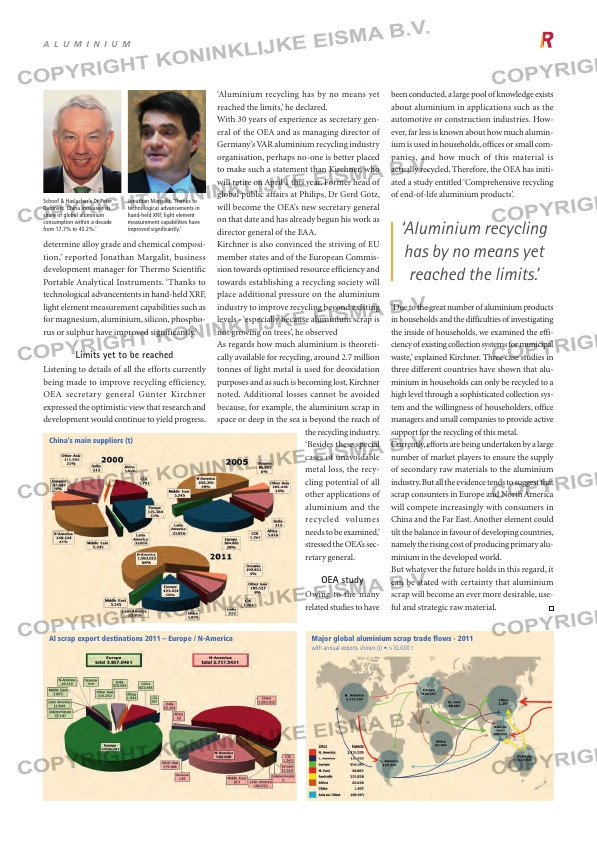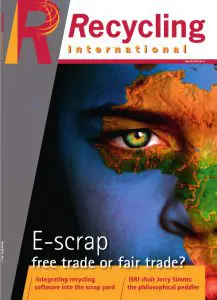Page 71 from: March 2013

A L U M I N I U M
determine alloy grade and chemical composi-
tion,’ reported Jonathan Margalit, business
development manager for Thermo Scientific
Portable Analytical Instruments. ‘Thanks to
technological advancements in hand-held XRF,
light element measurement capabilities such as
for magnesium, aluminium, silicon, phospho-
rus or sulphur have improved significantly.’
Limits yet to be reached
Listening to details of all the efforts currently
being made to improve recycling efficiency,
OEA secretary general Günter Kirchner
expressed the optimistic view that research and
development would continue to yield progress.
Al scrap export destinations 2011 – Europe / N-America Major global aluminium scrap trade fl ows – 2011
with annual exports shown (t) • >10.000 t
‘Aluminium recycling has by no means yet
reached the limits,’ he declared.
With 30 years of experience as secretary gen-
eral of the OEA and as managing director of
Germany’s VAR aluminium recycling industry
organisation, perhaps no-one is better placed
to make such a statement than Kirchner, who
will retire on April 1 this year. Former head of
global public affairs at Philips, Dr Gerd Götz,
will become the OEA’s new secretary general
on that date and has already begun his work as
director general of the EAA.
Kirchner is also convinced the striving of EU
member states and of the European Commis-
sion towards optimised resource efficiency and
towards establishing a recycling society will
place additional pressure on the aluminium
industry to improve recycling beyond existing
levels – ‘especially because aluminium scrap is
not growing on trees’, he observed
As regards how much aluminium is theoreti-
cally available for recycling, around 2.7 million
tonnes of light metal is used for deoxidation
purposes and as such is becoming lost, Kirchner
noted. Additional losses cannot be avoided
because, for example, the aluminium scrap in
space or deep in the sea is beyond the reach of
the recycling industry.
‘Besides these special
cases of unavoidable
metal loss, the recy-
cling potential of all
other applications of
aluminium and the
recycled volumes
needs to be examined,’
stressed the OEA’s sec-
retary general.
OEA study
Owing to the many
related studies to have
Jonathan Margalit: ‘Thanks to
technological advancements in
hand-held XRF, light element
measurement capabilities have
improved signifi cantly.’
been conducted, a large pool of knowledge exists
about aluminium in applications such as the
automotive or construction industries. How-
ever, far less is known about how much alumin-
ium is used in households, offices or small com-
panies, and how much of this material is
actually recycled. Therefore, the OEA has initi-
ated a study entitled ‘Comprehensive recycling
of end-of-life aluminium products’.
‘Due to the great number of aluminium products
in households and the difficulties of investigating
the inside of households, we examined the effi-
ciency of existing collection systems for municipal
waste,’ explained Kirchner. Three case studies in
three different countries have shown that alu-
minium in households can only be recycled to a
high level through a sophisticated collection sys-
tem and the willingness of householders, office
managers and small companies to provide active
support for the recycling of this metal.
Currently, efforts are being undertaken by a large
number of market players to ensure the supply
of secondary raw materials to the aluminium
industry. But all the evidence tends to suggest that
scrap consumers in Europe and North America
will compete increasingly with consumers in
China and the Far East. Another element could
tilt the balance in favour of developing countries,
namely the rising cost of producing primary alu-
minium in the developed world.
But whatever the future holds in this regard, it
can be stated with certainty that aluminium
scrap will become an ever more desirable, use-
ful and strategic raw material.
Schoof & Haslacher’s Dr Peter
Dahmen: ‘China increased its
share of global aluminium
consumption within a decade
from 17.7% to 43.2%.’ ‘Aluminium recycling
has by no means yet
reached the limits.’
China’s main suppliers (t)
RI_2-AluRIindd.indd 71 06-03-13 11:59



